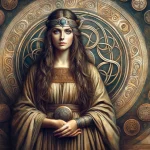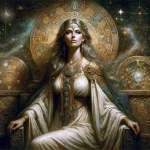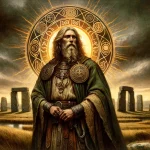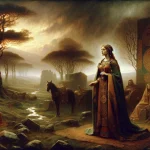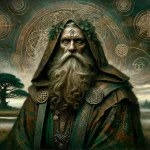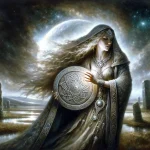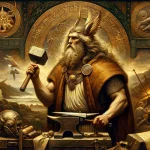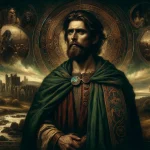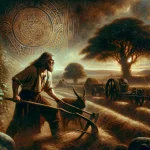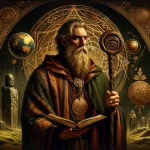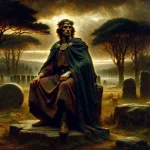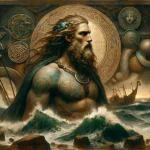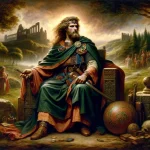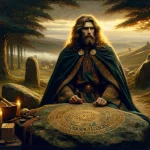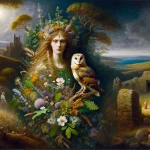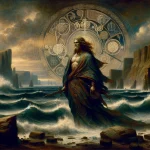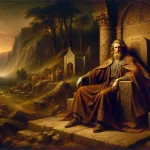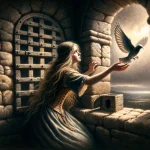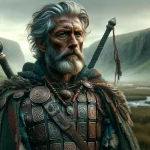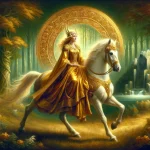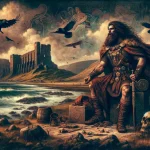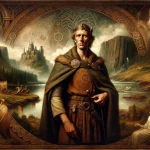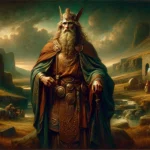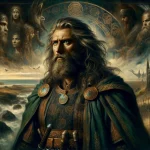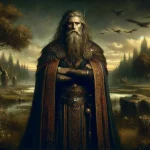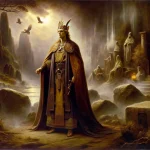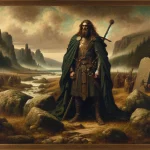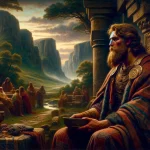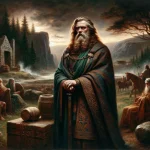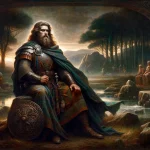In modern commentary on Welsh mythology, the pantheon is commonly seen as divided into two opposing factions: the Children of Dôn and the the powers of light and the Children of Llyr and the powers of darkness. Their stories are mainly told in the four tales of the Mabinogi, but characters are mentioned in other tales and poems such are The Battle of the Trees (Cad Goddeu), Culhwch and Olwen
- The Battle of the Trees
- The First Branch of the Mabinogi: Pwyll Pendeuc Dyfed
- Math Son of Mathonwy
- Culhwch and Olwen
- The Second Branch of the Mabinogi: Branwen Daughter of Llyr
- Manawydan mab Llŷr
The House of Dôn
The Children of Dôn trace their lineage back to the goddess Dôn and the god Beli, and are often likened to the Tuatha Dé Danann of Irish mythology. Interestingly, both pantheons feature a mother goddess with similar names: Danann (nowadays Danu) or Anann (Anu) for the Irish, and Dôn or Anna for the Welsh. It’s believed that the names Danu and Dôn may both stem from the Proto-Indo-European “danu,” meaning “river,” which is evident in the Don River in Scotland and the Danube in Europe, regions historically associated with the Celts. Dôn’s brother, Math, is the king of Gwynedd.
Children of Dôn
Amaethon (God of Agriculture): Amaethon is known primarily as a god of agriculture and farming. His name suggests a connection to cultivation and husbandry. Amaethon is less prominent in surviving texts, but he is notably mentioned in the medieval Welsh prose tale “Culhwch and Olwen,” where he is described as a skilled and significant agricultural deity.
Arianrhod: Arianrhod is a significant character in the Fourth Branch of the Mabinogi. She is the sister of Gwydion and the mother of Lleu Llaw Gyffes. Arianrhod is known for her beauty and her role in a famous episode where she inadvertently names Lleu and contributes to a curse that impacts his destiny. Her character is often associated with sovereignty, celestial bodies, and virginity, and her narrative reflects themes of autonomy, shame, and familial relationships.
Gilfaethwy: Gilfaethwy is another character from the Fourth Branch of the Mabinogi. He is Gwydion’s brother and is primarily known for his unlawful desire for Goewin, the maiden of King Math, which sets off a series of events in the narrative. Gilfaethwy’s actions, driven by lust, result in significant consequences for himself and others, leading to transformations and punishments. His story explores themes of desire, transgression, and the consequences of one’s actions.
Govannon: Govannon, also known as Gofannon, is typically associated with smithing and metalworking, similar to the Irish Goibniu and the Gaulish Gobannus. As a divine smith, Govannon’s skills are crucial in crafting weapons for the gods. He is mentioned in the medieval Welsh prose tale “Culhwch and Olwen”. In Welsh tradition, he is sometimes linked to the tragic tale of killing his nephew, Dylan ail Don, which adds a layer of complexity to his character.
Gwydion: Gwydion, also in the Fourth Branch of the Mabinogi is a powerful magician and trickster, he is known for his intelligence, magical prowess, and mastery of the arts. Gwydion is the uncle of Lleu Llaw Gyffes and plays a central role in his upbringing. His most notable deeds include the creation of a woman out of flowers as a wife for Lleu and his involvement in the transformation of Lleu into an eagle. Gwydion is often viewed as a heroic and complex figure, whose actions and schemes have far-reaching and sometimes unforeseen consequences.
Gilfaethwy: Appears with his brother Gwydion in the Fourth Branch of the Mabinogi. Gilfaethwy is most infamously known for his uncontrolled and illicit desire for Goewin, the virgin footholder of King Math. His passion leads him to conspire with his brother Gwydion to distract Math, resulting in Goewin’s violation. This act sets off a chain of events marked by deceit, transformation, and punishment. Gilfaethwy and Gwydion are both subjected to a series of magical transformations as punishment for their transgression.
Elestron: Elestron a lesser known child of Dôn. He is mentioned in the Book of Taliesin with his brothers.
Other Children of Dôn: In the Bonedd yr Arwyr the Plant Don o Arvon following children of Dôn are also mentioned: Hunawg, Idawl, IIenuydd, Digant, Kynnan, Hedd, Addien and Elawg.
Grandchildren of Dôn
Lleu Llaw Gyffes: Lleu Llaw Gyffes is a prominent figure in the Fourth Branch of the Mabinogi. Born under unusual and magical circumstances, he is the son of Arianrhod, who rejects him at birth, and his upbringing is marked by challenges set forth by his mother’s curses. Despite these obstacles, Lleu grows into a skilled and capable individual, under the guidance of his uncle Gwydion, a powerful magician.
Dylan ail Don: Like his brother Lleu Llaw Gyffes, Dylan features in the “Four Branches of the Mabinogi.” and is the son of Arianrhod. Dylan’s story is shrouded in the mystique of the sea, as he is often associated with the ocean and its wonders. Upon his baptism, he immediately took to the sea and became a being of the waters, possessing the ability to swim like a fish and being as comfortable in water as on land. This affinity with the sea earned him the epithet “Dylan Eil Ton” (Dylan Son of the Wave). His life, however, was marked by tragedy; he was killed by his uncle Govannon. Dylan’s death is said to have caused the waters of Britain to mourn, a testament to his deep connection with the sea. His character embodies the ancient Celts’ reverence for the natural world and their belief in the thin veil between the earthly realm and the otherworldly.
The House of Llyr
This house is associated with the deity Llyr, a figure often equated with the Irish sea god Lir. Members of this house are frequently associated with the sea and water. Llyr was the husband to Penarddun.
The Children of Llyr and Penarddun
Bran the Blessed (Bendigeidfran): Bran the Blessed, a giant and the king of Britain in Welsh mythology, is a central character in the Mabinogi, specifically the second branch. Renowned for his great size and wisdom, Bran owns a magical cauldron with the power to resurrect the dead. His story is marked by tragedy, notably during a war with Ireland triggered by the mistreatment of his sister, Branwen. Bran is a symbol of sacrifice; he instructs his followers to decapitate him after his death in battle, and his head continues to provide them guidance and company.
Branwen: Branwen, the sister of Bran the Blessed and a key figure in Welsh mythology, is featured in the Mabinogi. Her story unfolds with her marriage to the King of Ireland, which initially is a diplomatic triumph but later turns tragic. Branwen endures significant hardship in Ireland due to political strife, and her mistreatment eventually leads to a catastrophic war between Britain and Ireland. Branwen is often seen as a figure of sovereign power and suffering, embodying the complexities of political marriages in ancient times.
Manawydan: Manawydan, another son of Llŷr, is featured in the Mabinogi, notably in the third branch. Unlike his warlike siblings, Manawydan is characterized more by his wisdom and pacifism. After the catastrophic war and the loss of his family, he becomes a central figure in restoring peace and order. His story involves magical and enchanting adventures, as he confronts various supernatural challenges. Manawydan’s tales emphasize intelligence and cunning over brute strength, showcasing a different kind of heroism.
The Children of Penarddun and Euroswydd
Efnisien: Efnisien, a relatively lesser-known but pivotal character in the Mabinogi, is known for his impulsive and often destructive behavior. He is the half-brother of Branwen and plays a crucial role in the narrative of the second branch. Efnisien’s actions are the catalyst for the war between Ireland and Britain; in a fit of rage, he mutilates the horses given by the Irish king, an act that sets off a chain of tragic events. Despite his turbulent nature, Efnisien ultimately redeems himself through a self-sacrificing act that turns the tide during the war, highlighting themes of redemption and the complexity of human nature.
Nisien: Nisien is the twin brother named Efnisien. Nisien is characterized quite distinctly from his twin. He is described as a peacemaker with a good and gentle nature. This contrasts sharply with Efnisien, who is depicted as a troublemaker and instigator of conflict. The differences between Nisien and Efnisien are pivotal to the narrative, with their actions and personalities having significant impacts on the unfolding events.
Plant Annwn
Annwn or Annwfn is depicted as a paradisiacal realm, a world of delights and eternal youth, yet also one of profound mystery and enchantment. Annwfn is often linked with elevated landscapes such as hills and islands, which might have once been burial sites for Pre-Celtic and Celtic tribes. In the tale of “Pwyll,” Annwfn is depicted as a world parallel to ours, sharing many similarities yet filled with magical beings and just as perilous. The poem “Preiddeu Annwfn” describes it as a series of islands that King Arthur and his knights explore in pursuit of a mystical cauldron. This narrative echoes elements found in “The Mabinogion,” particularly in the story of “Branwen ferch Lyr,” where the quest for the cauldron is set in Ireland, not the islands of Annwfn.
Gwyn ap Nudd: Gwyn ap Nudd is a prominent figure in Welsh mythology, known as the king of the Otherworld, Annwn, and associated with the wild hunt, the dead, and the supernatural. His name translates to “Gwyn, son of Nudd,” indicating his lineage as the son of Nudd, a deity linked with mythological tradition. Gwyn ap Nudd’s realm, Annwn, is portrayed as a paradisiacal yet mysterious land, often equated with the land of the dead. He is often depicted as a formidable warrior and hunter, leading a ghostly entourage through the skies on his spectral horse, accompanied by his white, red-eared hounds, known as the Cŵn Annwn.
Arawn: Arawn, the king of Annwn, the Welsh Otherworld, is a key character in the First Branch of the “Mabinogion.” His encounter with Pwyll, where they exchange places, highlights Arawn’s wisdom and magical power. Arawn’s rivalry with Havgan forms a significant part of the narrative. As a ruler of Annwn, Arawn is associated with the themes of death, the supernatural, and the fluid boundary between the mortal world and the Otherworld. His portrayal in the Mabinogion blends sovereignty with mystical aspects of ancient Welsh mythology.
Havgan: Havgan, also a ruler in Annwn, appears as Arawn’s opponent in the First Branch of the “Mabinogion.” His conflict with Arawn is central to Pwyll’s adventure in the Otherworld. Havgan is eventually defeated by Pwyll, who has taken on Arawn’s appearance as part of their agreement. Havgan’s character, although less detailed than others, represents antagonism and conflict within the Otherworld, offering a contrast to Arawn’s more benevolent rule. His defeat is crucial for maintaining balance and harmony in Annwn and symbolizes the triumph of unity over discord.
Hefeydd Hen: Known as “Hefeydd the Old,” he is chiefly recognized as the father of Rhiannon, a pivotal character in the mythological narrative. His role, while not extensively detailed, is crucial in the unfolding of the story, particularly concerning Rhiannon’s marital prospects and her eventual union with Pwyll, Prince of Dyfed.
Rhiannon: Rhiannon, a captivating and enigmatic figure in Welsh mythology, is primarily known from “The Mabinogi,” especially the first and third branches of these medieval Welsh tales. Portrayed as a strong, resourceful, and often otherworldly woman, Rhiannon defies the typical damsel-in-distress archetype. Her story begins with a mystical meeting with Pwyll, Prince of Dyfed, leading to their marriage.
Lords of the Realm
Matholwch: Matholwch, prominently features in the Second Branch of the “Mabinogion,” known as “Branwen ferch Llŷr.” He is the King of Ireland and becomes a central figure through his marriage to Branwen, the sister of Bran the Blessed, the King of Britain.
Pwyll: Pwyll, a central figure in the “Mabinogion,” particularly in the First Branch, “Pwyll Pendefig Dyfed,” is the Prince of Dyfed in Wales. His story is notable for his encounter with Arawn, the king of the Otherworld, Annwn. Pwyll agrees to trade places with Arawn for a year and a day, a test that leads to a strong alliance between the two and demonstrates Pwyll’s honour and bravery. Pwyll’s narrative also includes his meeting and marriage to Rhiannon, a mystical woman of great beauty and strength. His journey is one of both kingly responsibility and personal growth, marked by trials, loyalty, and justice.
Pryderi: Pryderi, a significant figure in Welsh mythology, is featured prominently in the “Mabinogion,” particularly in the First, Third, and Fourth Branches. He is the son of Pwyll, Prince of Dyfed, and Rhiannon, a figure associated with the mystical and the divine. His life is marked by extraordinary events from his very birth; he is mysteriously abducted as an infant, only to be returned to his parents in a miraculous turn of events. Pryderi later inherits the rule of Dyfed from his father and marries Cigfa. His character is deeply intertwined with the magical and the supernatural. In the Third Branch, he falls under a spell that brings desolation over Dyfed, leading to a series of adventures with Manawydan, his mother’s second husband.
